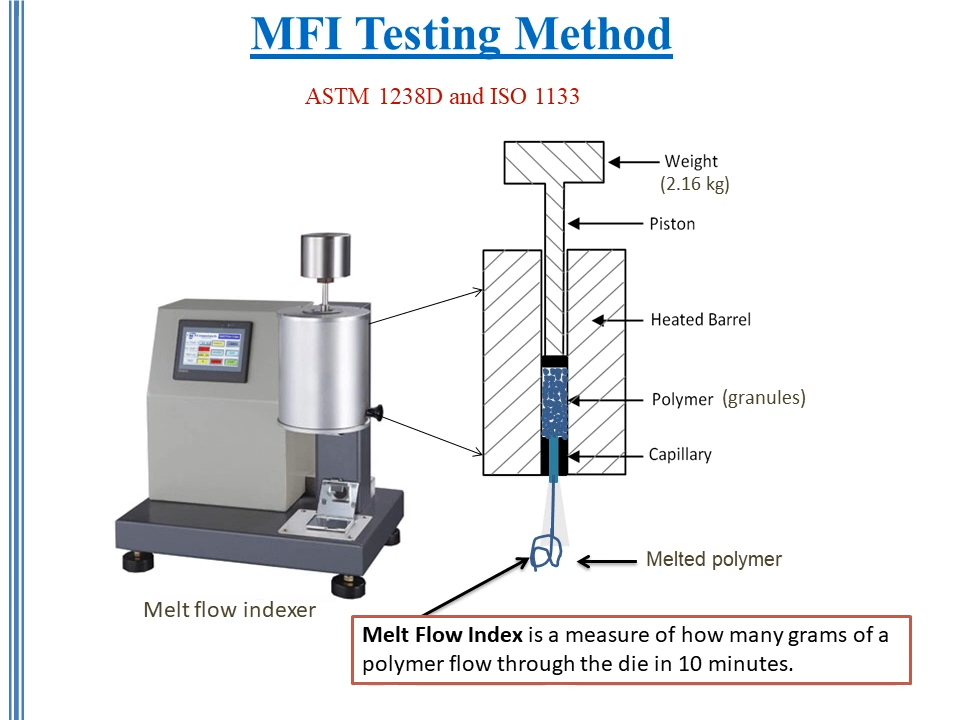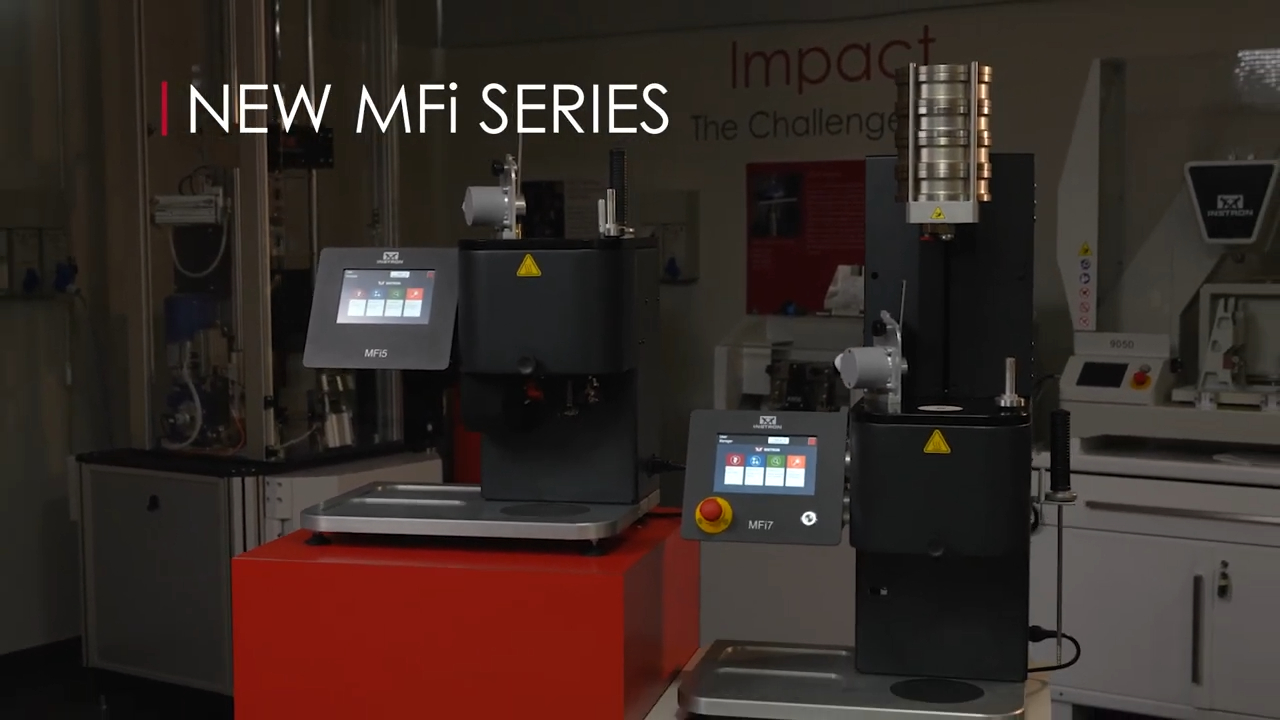What makes polymers easy to shape and process? The answer lies in the Melt Flow Index (MFI). MFI measures how easily a polymer melts and flows, playing a crucial role in polymer manufacturing. It's vital for selecting the right processing method and ensuring product quality. In this post, you'll learn the fundamentals of MFI, its importance in polymer processing, and how it impacts product performance. We’ll also explore factors that influence MFI, ways to modify it, and how it’s used in quality control.

What is Melt Flow Index (MFI)?
Melt Flow Index (MFI) serves as a critical quality control parameter measuring polymers' flowability or melt viscosity. It indicates how easily molten polymers flow under specific pressure and temperature conditions.
Understanding MFI and Its Measurement
MFI represents the mass flow rate measured through a standardized die under prescribed conditions:
MFI as Flow Property Indicator
MFI correlates directly to several polymer characteristics:
Molecular Properties:
Processing Behavior:
Application Suitability:
High MFI (>10 g/10min) → Injection molding
Medium MFI (2-10 g/10min) → Extrusion
Low MFI (<2 g/10min) → Blow molding
Principle of MFI Testing
The testing process follows standardized procedures ensuring reliable results:
Basic Testing Steps:
Critical Parameters:
Standard Test Conditions (Examples):
| Polymer Type | Temperature (°C) | Load (kg) |
| Polyethylene | 190 | 2.16 |
| Polypropylene | 230 | 2.16 |
| Polystyrene | 200 | 5.0 |
Testing Procedure Importance
Accurate MFI measurement demands strict adherence to protocols:
Consistent sample preparation
Proper equipment calibration
Standard testing conditions
Regular maintenance
Skilled operator technique
We recommend following ISO 1133 or ASTM D1238 standards for reliable results. These procedures ensure reproducibility and comparability across different testing facilities.
Note: MFI values help determine suitable processing methods and end applications. Understanding MFI enables manufacturers to optimize production parameters effectively.
Relationship between MFI and Polymer Properties
The correlation between MFI and polymer properties proves fundamental in determining processing methods and final product characteristics. Understanding these relationships enables manufacturers to optimize their production processes effectively.
MFI-Molecular Weight Correlation
MFI exhibits an inverse relationship to molecular weight, following an empirical equation for linear polymers:
log MW = 2.47 – 0.234 log MF
Where:
Key correlations:
Higher MFI values indicate lower molecular weight polymers, offering easier processability but potentially reduced mechanical properties
Lower MFI values suggest higher molecular weight polymers, providing enhanced mechanical strength but requiring more intense processing conditions
Molecular Weight Distribution Effects
The distribution of molecular weights significantly influences MFI behavior through several mechanisms:
Broad Distribution: Polymers exhibiting wide molecular weight ranges demonstrate complex flow behaviors, affecting their processability and requiring careful control of processing parameters to achieve optimal results.
Narrow Distribution: Materials possessing tight molecular weight distributions show more predictable flow characteristics, enabling precise control during processing but potentially limiting their application versatility.
Viscosity-MFI Relationship
The inverse relationship between viscosity and MFI manifests through multiple factors:
Temperature Dependency:
Higher temperatures reduce viscosity, increasing MFI
Each 10°C change typically modifies MFI by 20-30%
Shear Rate Effects:
Processing Method Compatibility
Different processing techniques require specific MFI ranges for optimal performance:
| Processing Method | Recommended MFI Range (g/10min) | Key Applications |
| Injection Molding | 8-20 | Technical parts, containers |
| Blow Molding | 0.3-2 | Bottles, containers |
| Extrusion | 2-8 | Films, sheets, profiles |
| Fiber Spinning | 10-25 | Textile fibers, nonwovens |
Product-Specific Applications
MFI values significantly influence final product characteristics:
High MFI Applications (>10 g/10min):
Medium MFI Applications (2-10 g/10min):
Low MFI Applications (<2 g/10min):
Note: These ranges serve as guidelines. Specific applications might require values outside these ranges based on equipment capabilities and product requirements.
Factors Affecting Melt Flow Index
The accuracy and reliability of MFI measurements depend on multiple variables. Understanding these factors enables precise quality control and consistent polymer processing outcomes.
Temperature Effects
Temperature significantly influences MFI measurements through several mechanisms:
Viscosity Changes:
Higher temperatures decrease polymer melt viscosity, resulting in increased flow rates and higher MFI values, while affecting molecular chain mobility and polymer structure stability during testing procedures.
Molecular Mobility:
Degradation Risk:
Pressure Influence
Pressure variations impact MFI measurements through complex rheological behaviors:
Melt Compressibility:
Flow Behavior:
Sample Preparation Impact
Proper sample preparation proves crucial for accurate MFI determination:
Moisture Control:
Physical Condition:
Adjusting Testing Parameters
Temperature Control Protocols
Implementation of strict temperature management:
Pressure Standardization
Maintaining consistent pressure conditions:
| Standard | Pressure Range (kg) | Temperature Range (°C) |
| ASTM D1238 | 2.16 - 21.6 | 190 - 300 |
| ISO 1133 | 2.16 - 21.6 | 190 - 300 |
Sample Quality Assurance
Essential preparation steps:
Pre-Testing Procedures:
Material Conditioning:
Loading Technique:
Melt Flow Index Testing Equipment and Standards
Modern MFI testing equipment combines precision measurement capabilities and user-friendly operation. Advanced features ensure reliable quality control through standardized testing procedures.
Equipment Overview
The Presto MFI tester exemplifies modern testing capabilities:
Control Systems
Measurement Features
Safety Features
Standards Compliance
Modern testers meet rigorous international standards:
| Standard | Requirements | Applications |
| ASTM D1238 | Temperature ±0.5°C, Standard die dimensions | Global manufacturing |
| ISO 1133 | Enhanced temperature control, Strict timing | European certification |
User-Friendly Features
Control Interface
Digital display shows real-time temperature, pressure, and flow measurements.
Programmable test parameters streamline repeated testing procedures.
Automated data logging eliminates manual recording errors.
Reliability Features
Self-diagnostic systems identify potential issues before testing begins.
Calibration verification ensures consistent measurement accuracy.
Temperature stabilization maintains precise testing conditions.
Operating Procedures
1. Equipment Setup
Machine Positioning
Place the testing unit on a stable, vibration-free surface for accurate measurements.
Adjust leveling feet until bubble indicator shows perfect horizontal alignment.
Digital Configuration
Program test duration through the digital interface control panel.
Set temperature parameters according to material testing requirements.
Configure data collection intervals for comprehensive result analysis.
Sensor Management
Calibrate RTD PT-100 sensor according to manufacturer specifications.
Verify temperature readings against calibrated external reference standards.
Document calibration results for quality control records.
System Optimization
Enable auto-tune feature for optimal temperature control performance.
Monitor system response during initial heating phase.
Verify stable operating conditions before beginning tests.
Pre-test Checklist
[ ] Equipment leveling verified through bubble indicator readings
[ ] Temperature stabilization achieved within specified tolerances
[ ] Sample material properly prepared and conditioned
[ ] Test parameters configured according to standard requirements
Note: Regular maintenance ensures consistent equipment performance. Document all calibration procedures.

MFI of Filled Polymers and Composites
The incorporation of fillers significantly influences polymer MFI values. Understanding these effects enables optimal processing parameter selection for filled polymer systems.
Filler Impact Analysis
Reinforcing Fillers
Glass Fiber
Metal Powders
Non-Reinforcing Fillers
Calcium Carbonate
Talc
Processing Considerations
High MFI Base Polymers
Enable effective filler dispersion throughout the polymer matrix
Provide improved processing characteristics under standard conditions
Maintain acceptable flow properties at higher filler loadings
Low MFI Base Polymers
Result in challenging filler dispersion processes
Require modified processing parameters for effective production
Show limited compatibility at increased filler concentrations
Hygroscopic Materials Management
Moisture-Sensitive Polymers
| Polymer Type | Drying Temperature (°C) | Maximum Moisture Content |
| Nylon | 80-85 | 0.2% |
| PET/PBT | 120-140 | 0.02% |
| ABS | 80-85 | 0.1% |
| PC | 120-125 | 0.02% |
Pre-drying Requirements
Temperature Control
Time Management
Material Classification
Hygroscopic Polymers
Engineering Plastics
Technical Polymers
Non-Hygroscopic Polymers
Commodity Plastics
Note: Regular moisture content verification ensures consistent processing results.
MFI of Recycled Polymers and Polymer Blends
The growing demand for sustainable manufacturing has led to increased use of recycled polymers in polymer processing. However, mechanical recycling and polymer blending can significantly affect the Melt Flow Index (MFI), which impacts material performance and processing efficiency.
MFI Changes During Recycling
Degradation Effects
Molecular Weight Reduction
Mechanical stress during recycling breaks polymer chains, increasing overall melt flow rates.
Thermal exposure during reprocessing accelerates chain scission and molecular degradation processes.
Property Changes
MFI Modification Strategies
Chain Extension Technology
Chemical Modification
Process Implementation
Original MFI → Chain Extender Addition → Modified MFI
High Flow Rate → Molecular Weight Increase → Controlled Flow Properties
Performance Enhancement
| Modification Method | MFI Impact | Application Benefits |
| Chain Extension | Decreases MFI | Improved mechanical properties |
| Peroxide Addition | MFI control | Enhanced processing stability |
| Blend Optimization | Targeted MFI | Application-specific properties |
Polymer Blend Characteristics
Virgin-Recycled Combinations
Blend Ratios
Processing Windows
Quality Control Measures
Testing Protocols
Regular Monitoring
Property Verification
Optimization Strategies
Material Selection
Process Control
Conclusion
Melt Flow Index (MFI) plays a crucial role in polymer processing and quality control. It helps manufacturers select the right materials and optimize production. Understanding factors that affect MFI, like molecular weight and processing conditions, is essential for improving product quality. Adjusting for these factors ensures consistent results during manufacturing.
Incorporating MFI testing in your polymer testing procedures is key to enhancing production efficiency. It ensures that polymers meet required standards and perform well in real-world applications. Regular MFI testing is a simple step toward better polymer processing and product reliability.
Reference Sources
Melt flow index
PPS Plastic
Plastic Injection Molding

















